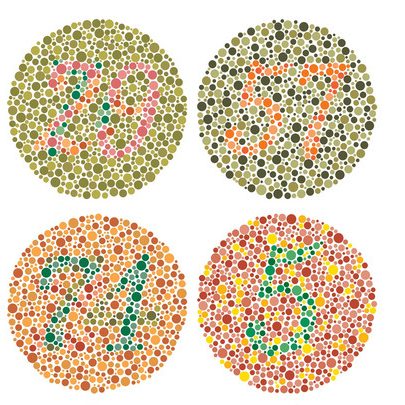ISHIHARA COLOR BLIND TEST
The detection and study of color blindness

Cones are cells which are sensitive to light and which are found in the retina in the so-called photo-receptive layer. These cells are responsible for our color vision.
The Ishihara color blind test.
In human beings and in many other primates there exist three different types of cones, each of which is sensitive in a selective way to light of a certain wavelength, green, red or blue. The brain interprets colors based on the cause of stimulation of the three types of cones. .
Colorblindness is a genetic defect which means that there is difficulty in distinguishing colors. How much a person is affected varies greatly and ranges between the lack of capacity to discern any color (achromatopsia) and a slight degree of difficulty to distinguish some shades of red, green and occasionally, blue. This can be detected by means of specific visual tests such as Ishihara cards.
The genetic defect is hereditary and is generally transmitted by a recessive trait linked to the X chromosome. If a male inherits an X chromosome with this deficiency he will be color-blind. However, in the case of females who have two X chromosomes, they will only be color-blind if both of their X chromosomes have the deficiency. For this reason color-blindness affects approximately 1.5% of men but only 0.5% of women.
There exist different types of color-blindness :
- Achromatic: The individual has none of the three types of cones or these do not function. This only affects one person in every 100,000. It is the most serious type of color-blindness and means that the individual who suffers from it can see only differences in shades of gray.
- Monochromatic: People who have this type of color-blindness only have two types of cones, and as they have one of the types of cells missing the other becomes responsible for receiving the stimuli which would correspond to the first.
There are three different types : Protanopia, deuteranopia and tritanopia. - Protanopia: Consists in the total absence of red retinal photoreceptors.
- Deuteranopia: Is due to the absence of green retinal photoreceptors
- Tritanopia: Is extremely uncommon as the blue retinal photoreceptors are absent.
- Trichromatic Anomaly: The person affected has all three types of cones but with functional defects, which leads to them confusing one color for another. This is the largest and most common of the color-blind groups. They have three types of cones but perceive the shades of colors in an altered way.They usually have similar defects to people with dichromatic color-blindness, but it is less noticeable.
